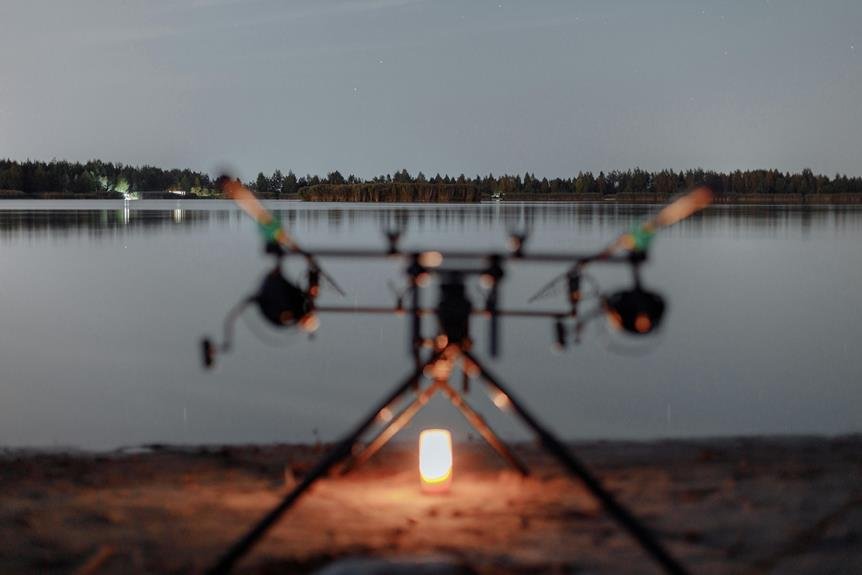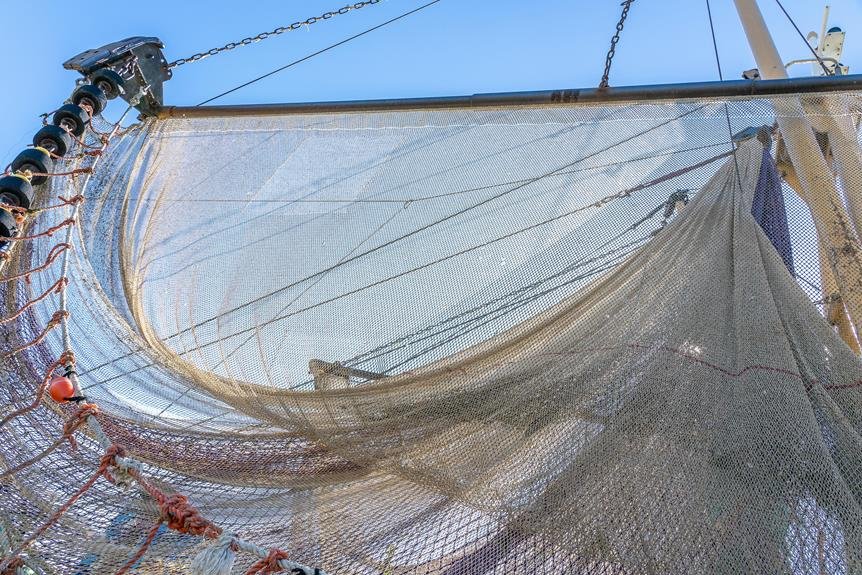We rely on a handful of trusty fishing line joining knots to connect our lines and leaders, guaranteeing a reliable connection that can withstand the toughest fights. To establish a secure bond, we use knots like the Double Surgeons, Double Uni, Albright, and Blood knots, each with its unique strengths and applications. Mastering these knots is crucial for a successful catch, and we're excited to explore the world of line joining techniques and uncover the secrets to a more enjoyable and rewarding fishing experience – and we're just getting started on this journey.
Key Takeaways
- Mastering various fishing line joining knots is vital for a reliable connection between lines, ensuring a successful catch.
- Different knots serve specific purposes, and knowing when to use each one is crucial in different fishing scenarios.
- The Double Surgeons Knot, Double Uni Knot, Albright Knot, and Blood Knot are popular and reliable line joining knots for various fishing situations.
- Mastering line joining techniques increases confidence in tackling various fishing situations, reducing gear-related worries and enhancing the fishing experience.
- Well-tied knots guarantee the line can withstand fish strength, reducing breakage risk and leading to a more successful and enjoyable fishing experience.
Types of Fishing Line Knots
When we're out on the water, we need a reliable connection between our lines, and that's where mastering various fishing line joining knots comes in – knowing which knot to use in different situations is vital. We've found that surgeons knots are popular fly fishing knots and are one of the strongest line-to-line knots. Double uni knots are great for attaching leader to main line and work with lines of the same or different materials. Albright knots are popular fly line knots used for tying together two lines of unequal weight. Understanding the strengths of each knot is essential for choosing the right one for our fishing techniques. By comparing knot strength, we can make informed decisions about which knot to use in different situations, ensuring a secure connection and minimizing the risk of losing a catch.
Understanding Double Surgeons Knot
As we explore the world of fishing line joining knots, we're now going to take a closer look at the Double Surgeons Knot, a reliable connection that's easy to tie and incredibly strong.
| Knot Feature | Description |
|---|---|
| Knot Strength | The Double Surgeons Knot is known for its exceptional strength, making it a great choice for joining lines. |
| Line Materials | This knot works well with monofilament, fluorocarbon, and braided lines, making it a versatile option. |
| Ease of Tying | The Double Surgeons Knot is relatively easy to tie, even for beginners. |
| Applications | It's commonly used for joining two lines of similar or different materials, making it a great all-around knot. |
Tying a Strong Double Uni Knot
We're going to explore the world of Double Uni Knots, a reliable connection that's easy to tie and incredibly strong. When tying a Double Uni Knot, we prioritize knot strength and line flexibility. We start by leaving plenty of line at the end of the knot on each piece of line being joined. Then, we form a loop in the left-hand portion of the overlap that goes clockwise. Next, we pass that line around the other line and through the loop five times. This knot is great for attaching leader to main line and works with lines of the same or different materials. With a Double Uni Knot, we can rest assured that our lines are securely connected, giving us the confidence to reel in those big catches.
The Purpose of Albright Knots
Now that we've mastered the Double Uni Knot, let's explore the Albright Knot, a popular fly line knot used for tying together two lines of unequal weight. The Albright Knot is a reliable choice when we need to join a heavy fly line to a lighter leader or tippet. Its purpose is to provide a strong connection between two lines of different weights, ensuring that our knot strength isn't compromised. When tying an Albright Knot, we're creating a secure bond between the fly line and leader, allowing us to focus on landing that big catch. By mastering this knot, we can confidently fish with lines of varying weights, knowing our connection is strong and reliable.
Blood Knots for Monofilament Lines
When joining sections of monofilament nylon line of similar weight, we rely on the Blood Knot, a trusted and reliable connection that maintains our lines stay intact. As fly fishing enthusiasts, it is common knowledge that line strength is crucial, and the Blood Knot delivers. This knot is particularly useful when joining two lines of similar diameter and material, ensuring a seamless connection that won't compromise our catch. By overlapping the lines and wrapping them around each other, we create a secure bond that withstands the test of the water. With the Blood Knot, we can confidently cast our lines, knowing our gear is up to the task.
Mastering Line Joining Techniques
As we move beyond the reliability of the Blood Knot, we find that mastering line joining techniques requires a deeper understanding of the various knots and their applications. We've learned that different knots serve specific purposes, and knowing when to use each one is vital. In our fishing strategies, we need to take into account the type of line, its weight, and the fishing situation. Effective line management is key to a successful catch. By mastering line joining techniques, we can confidently switch between lines, adapting to changing conditions on the water. With practice, we can develop a repertoire of knots to tackle any fishing scenario, giving us an edge in our fishing adventures.
Importance of Strong Line Connections
By relying on strong line connections, we guarantee that our carefully crafted lures and meticulously selected baits aren't wasted on avoidable line failures. Weak connections can lead to frustration and disappointment, especially after investing time and effort into a fishing trip. We've all been there – the thrill of reeling in a big catch, only to have it slip away due to a faulty knot. To avoid this, we prioritize strong line connections using reliable knots and suitable line materials. Here are three key benefits of strong line connections:
- Reduced gear loss: With secure connections, we minimize the risk of losing expensive lures and tackle.
- Increased confidence: Trust in our gear allows us to focus on our fishing techniques, rather than worrying about equipment failure.
- Improved catch rates: By reducing line failures, we can capitalize on every fishing opportunity, increasing our chances of landing more fish.
Choosing the Right Knot for Fishing
We've all been in situations where we've lost a fish due to a weak knot, which is why we need to choose the right knot for the job, considering factors like the type of fishing we're doing, the material of our lines, and the specific connections we need to make. Our fishing strategies depend on selecting the perfect knot for the task at hand.
| Fishing Strategy | Recommended Knot |
|---|---|
| Fly Fishing | Surgeon's Knot |
| Attaching Leader | Double Uni Knot |
| Joining Unequal Lines | Albright Knot |
Common Mistakes in Line Joining
When joining fishing lines, we often overlook simple mistakes that can lead to knot failure, costing us precious fish and time. As anglers, it's essential to recognize that mastering fishing fundamentals, including knot selection, is key to a successful fishing trip. However, even with the right knot, mistakes can occur. Three common mistakes to avoid:
- Insufficient wraps: Not wrapping the line enough times around the standing part of the line can lead to a weak knot.
- Inconsistent tension: Failing to maintain consistent tension while tying the knot can cause it to come undone.
- Inadequate trimming: Leaving excess tag ends can cause the knot to fail under stress.
Practicing Line Joining Knots Effectively
Now that we've identified common mistakes to avoid, we can focus on practicing line joining knots effectively, starting with creating a conducive practice environment that helps us develop muscle memory and consistency. We find a quiet spot, free from distractions, and gather our essential tools: lines, scissors, and a practice board. We start with simple knots, like the double uni, and gradually move on to more complex ones, like the Albright. As we tie each knot, we focus on the feel of the line, the twist of the twist, and the snug of the finished knot. With each repetition, our hands become more confident, our fingers more dexterous. We're building a strong foundation in knot tying, a fundamental skill that will elevate our fishing game.
Improving Fishing Skills With Knots
By mastering various line joining knots, we can substantially improve our fishing skills and increase our chances of landing more fish. As anglers, it's a fact that a well-tied knot can make all the difference between catching a trophy fish and losing it to a weak connection. By incorporating different knots into our fishing strategies, we can adapt to various fishing conditions and increase our success rate. Three key benefits of mastering line joining knots are:
- Improved Knot Safety: A well-tied knot guarantees that our line can withstand the strength of the fish, reducing the risk of breakage and lost catches.
- Increased Confidence: Mastering different knots gives us the confidence to tackle various fishing situations, from freshwater to saltwater fishing.
- Enhanced Fishing Experience: By being familiar with the right knots to use, we can focus on the thrill of fishing, rather than worrying about our gear.
Conclusion
As we cast our lines into the water, we're not just hoping to catch a big one – we're relying on the strength of our knots to bring it home. Like Odysseus tied to the mast, we're bound to our lines, trusting they'll hold fast against the forces of the deep. By mastering these fishing line joining knots, we're not just avoiding the agony of defeat – we're writing our own epic tale of fishing triumph.









